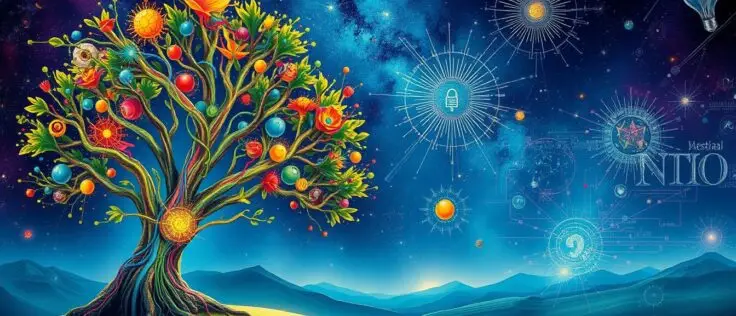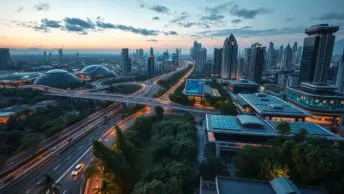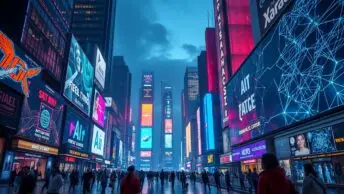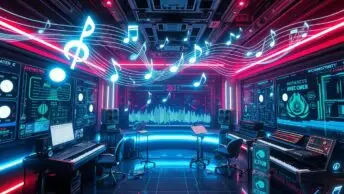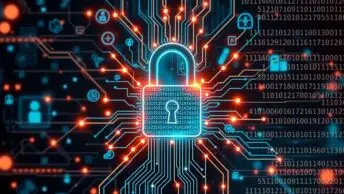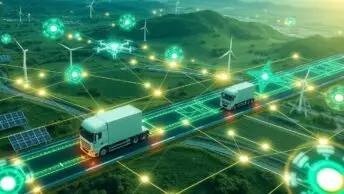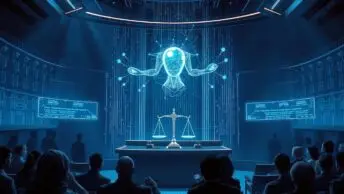Are we entering a new era where machines could end human creativity? Or is this the start of a great teamwork between humans and AI? OpenAI’s GPT-4, which has about one trillion parameters, is changing how we see creativity in art and technology1. This big jump in AI brings us closer to mixing human skills with machines, questioning the basic beliefs that separate our creativity from computers1.
The growth of AI tools like Dall-E shows they can make complex and detailed content, causing debates about what creativity really is1. In areas thought unique to human creativity, AI is making its mark. Classical music made by AI, such as “Aiva”, is now played by famous orchestras. This shows the deep connection between AI and human creativity2.
AI is changing our society by possibly automating tasks in many jobs. However, it’s also creating new ways to express ourselves that might change how we view artists and their work2. This blend of AI and human talent could lead to new jobs and cultural growth. It raises questions about the future and what we see as genuine and human-made3.
But is it right to see this AI and human blend as a partnership, not competition? AI opens doors to new jobs and makes us rethink the value of human work. We wonder: does AI add to our creative skills, or will it overshadow our human creativity3? The road ahead is both exciting and uncertain. It will blend technology and human creativity, offering both challenges and chances for AI and humans together.
The Evolving Nature of Creativity in the Digital Age
The digital age is changing creativity, especially with AI tools. These technologies change how we make content and what art means. Now, generative AI and learning algorithms are key in art, offering new ways to work together and improve creativity.
AI’s part in creativity helps make user experiences better too. With smart data analysis and learning, AI improves UX design. Designers and AI must work closely to make digital use smoother enhancing user experience with AI.
The future of arts like painting, music, and writing is linked with AI. This partnership leads to new experiences, like AI art shows, that change how we see art4.
The digital age and AI are reshaping creativity in big ways. This change not only opens new possibilities but also prepares us for future innovations. Here, humans and AI will work together, changing creativity’s rules.
The Definition and Scope of Human Creativity
Creativity is all about bringing new and valuable ideas to life. It thrives on mixing imagination with new concepts. At its heart, it involves special ways of thinking. These let people create ideas that are both new and useful. It blends imagination with practical thinking.
Understanding Creativity Through a Psychological Lens
The way psychology sees creativity highlights how our minds link different ideas in new ways. This ability for flexible thinking lets us solve hard problems with innovative solutions. It shows a deep understanding of creativity. This blend of thoughts sets human insight apart from artificial intelligence. AI can handle lots of data but can’t match humans’ skill in turning emotions and complex thoughts into something creative.
Imagination and Originality: Key Components of Creativity
At the heart of creativity are imagination and being original. Imagination helps us think beyond normal limits, leading to unique ideas. Originality then adds a twist that makes these ideas not just new but also surprising and meaningful. These factors are crucial in outlining human creativity’s range. It taps into emotional depth and personal experiences in ways AI can’t genuinely mimic. Read how AI is influencing marketing.
Whilegenerative AI aids creative processes by analysing and improving ideas which boost collective work and make innovation open to all6, it falls short of grasping human emotions and psychological complexity7. Where AI lacks, human creativity shines. It’s powered by strong emotional intelligence and a deep search for meaning. This drives real innovation and advancement7.
Generative AI: The New Frontier in Innovation
Generative AI is changing the game in creativity and innovation. It uses smart algorithms that can think up new things. This AI is starting a new chapter where tech meets art to create things once only humans could. The growth of tech like ChatGPT and Dall-E shows AI’s big role in boosting creative work.
How Machine Learning Algorithms Foster Creativity
Case Studies: ChatGPT and Dall-E
Generative AI is revolutionising artistic, scientific, and business fields. It’s behind new music and deep literary works. As AI grows, it bridges tech and human creativity. This helps both areas flourish together8.
AI and Human Creativity: A Collaborative Relationship
We’re seeing AI merge with human creativity, changing how we boost creativity and innovate. AI takes on simple tasks and sifts through big data sets. This not only increases productivity but also opens new ways for creativity at work9.
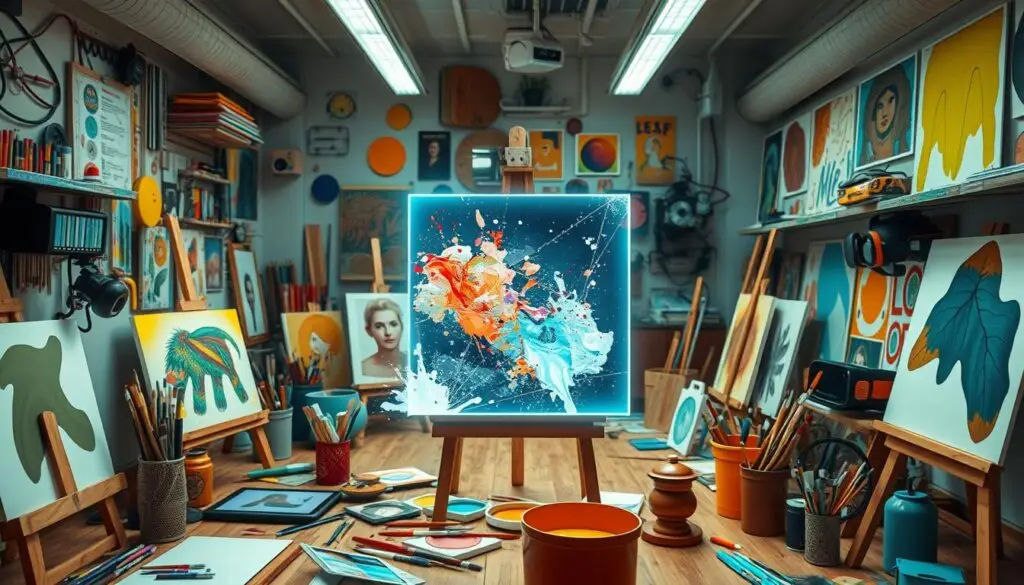
Even though some worry AI might take over jobs, things like emotional intelligence and empathy can’t be matched by machines9. AI actually helps push our creativity further, making the team work between humans and machines stronger than ever9.
Enhancing Creative Processes with AI Tools
AI can do the boring stuff so we can spend more time being creative and less on the mundane910. This not only gives us more room to think creatively but also enhances our skills in spotting patterns and analysing data, creating the perfect setting for new ideas9. For instance, in web design, AI tools help make sites better for users by understanding what they like, letting designers work on the more creative parts10.
The Symbiosis in Art and Technology Projects
Art and technology blend through AI, opening new paths for artists. They use AI to add to and grow their creative ways and ideas. This shows the strong connection between tech and artists, stressing the important role of working together in today’s art projects. AI can even study and make digital versions of art, doing storytelling through images that show off AI’s ability to come up with detailed stories and visuals based on what it sees9.
In summary, AI is key in developing creativity, whether in web design or art storytelling. This joint effort9 highlights how innovation changes when art and tech meet, making sure creativity isn’t just kept but also improved.
The Emotional Dimension: Human Experiences vs. AI Interpretations
When we compare human experiences with AI’s interpretations, we uncover deep insights. Our emotions and memories enrich our experiences in ways AI can’t fully grasp yet. While AI can analyze data and predict actions, it misses the real spark behind our creativity11.
AI relies on algorithms to mimic behaviors and foresee life events. But it struggles to grasp why we feel or act as we do11. This shows a big gap in what AI can do. Even with tech advances, it can’t mimic the emotional bonds in our art.
Mixing emotional with logical data can help businesses. It improves how they connect with customers and plan marketing. But it’s key to respect everyone’s privacy and freedom11. As AI like ChatGPT grows, the risk of losing real, human creativity rises as well. This worries many that our unique expressions could fade12.
The Role of AI in Idea Generation and Problem Solving
Artificial Intelligence, especially Generative AI, plays a crucial role in boosting innovation in creative jobs. It brings fresh ways to come up with ideas and solve creative problems. This helps industries looking for new and unique ideas13.
Big names like Google and Adobe are using AI to make their creative tools even better. These tools, powered by AI, give a wider variety of ideas. They challenge old ways of thinking and add rich diversity to brainstorming14.
AI is changing the game in creative problem solving by breaking old limits. It can find inspiration from different fields. This helps creative folks find new and surprising solutions. It might even lead to major innovations in their work14.
But creativity also needs human touch and context, which AI can’t copy yet. This shows the crucial role of creative people in adding depth to their work. AI should support, not replace, human creativity.
Using AI in creativity also comes with challenges. We need to be careful about data privacy, need a lot of training, and avoid relying too much on tech. Keeping a balanced view on AI use is key14.
Ending with, AI and human creativity together are creating new ways in idea generation and creative problem solving. As more creators use these tools, they see AI speeds up creating. It also brings a new way of thinking to the table, shaping the future of creative fields14.
Limitations of AI in Emulating True Human Creativity
The discussion about AI in the arts touches on its limitations in capturing human creativity. The Oxford Dictionary describes creativity as using imagination to invent something new15. This definition shows how AI struggles with aspects like feeling and personal touch, crucial in genuine art.
Even with tech progress, AI art focuses too much on what sells15. It uses existing patterns, leading to expected results16. This may not meet the needs of those wanting new and touching art. AI finds it hard to create work that connects deeply with people16. The unique human aspect in major art works can’t be replicated by AI, risking the variety and emotional depth in the art scene17.
There’s also worry about art becoming too similar17. AI, being data-driven, might make creative works too alike. This could demotivate artists from creating unique works, slowing down innovation17. Additionally, AI has trouble quickly understanding cultural changes or shifts in public mood, which makes its content less timely16.
These issues underline the gap between AI abilities and human creativity. AI can assist in creativity, but it’s vital to know its limitations. We must ensure human involvement to keep the unique value of human creativity and the genuine connection art provides16.
Future Perspectives: AI's Growing Impact on Creativity
The blend of artificial intelligence and creativity is creating a new future for many sectors. This change is most evident in the creative industries. As AI grows, it fuels big changes, especially in media, from music to digital art.
The Potential for AI to Reshape Creative Industries
Maintaining the Uniqueness of Human Artistry Amidst Technological Advancement
The journey of technology in the creative world looks promising. Mixing AI with human creativity could enrich art, making this a great time for new ideas and art forms. AI continues to change how we create, showing the endless possibilities when humans and machines work together18.
Conclusion
The joining of AI and human creativity marks a huge shift in how we make art and innovate today. It’s vital to think carefully about the ethics of combining the two. This is especially true as AI gets better at thinking and creating things, skills many job fields and cultures value21. Tools like MuseNet, Adobe’s Sensei, and DeepDream have opened up new ways to create art. But, it’s just as important to keep the special touch that only humans can bring to creativity21.
In the UK, the use of AI tools such as ChatGPT and Bard has greatly changed how content is made. However, these tools still can’t match the detailed understanding that human copywriters have22. Despite AI’s big changes in many creative fields – like fashion and film – it’s crucial to keep the human element in our creations. This protects our unique way of expressing ourselves as we explore new creative ideas23.
The partnership between AI and human creativity has sparked an important talk about ethics in the creative world. By seeing AI as a helper, not a replacement, creatives can use these tools to better their work. This won’t lessen the emotion or individuality in human art. Such a balance is key, especially in leading Language and Literature studies22. To understand more about using AI for better digital marketing strategies, look at how it’s changing search engine optimization
FAQ
How are AI and human creativity intersecting in today’s digital landscape?
AI and humans are working together on projects. AI helps with the creative process, offering fresh, innovative solutions. This teamwork marks a new era of deep human-machine interaction. It opens doors for fresh innovations in art and technology.
What role do AI tools play in modern creative processes?
AI tools are changing the way we create. They provide data-driven insights and handle boring tasks. This leaves us free to explore new ways of being creative. AI is a partner in brainstorming and making creative projects come to life.
How does psychological understanding of creativity relate to the capabilities of AI?
Understanding creativity means looking at how humans connect ideas and create something new. AI tries to do this, but it can’t match our personal insights or original thinking. This difference shows the unique nature of human creativity.
What distinguishes imagination and originality in human creativity compared to AI?
Human creativity shines through our ability to think up new ideas and share unique views. AI, on the other hand, can create new things but only from what it already knows. It doesn’t have our knack for making something truly original from our own experiences.
How are generative AI and machine learning algorithms contributing to creativity?
Generative AI and machine learning look at tons of data to make art, music, and more. They spot patterns and make things based on what they learn. This makes them useful tools for creative people.
What are some notable case studies that demonstrate AI’s capabilities in creativity?
Exciting examples include OpenAI’s ChatGPT, which writes poetry, and Dall-E, that creates images from words. These cases show how AI can support creative work and open new paths for creativity.
How does the emotional depth of human creativity compare with AI interpretations?
Our creativity comes from real feelings and personal experiences. This lets us express ourselves in deep and complex ways. AI may seem to get it right sometimes. Yet, it can’t match the depth of feeling and life stories that shape our art.
In what ways is AI used to generate ideas and solve creative problems?
AI helps by spotting patterns and coming up with options we might not see. It digs through lots of info to offer new ideas. It also helps start projects and shows us different views. This assistance is great for solving creative challenges.
What are the limitations of AI in reproducing the full spectrum of human creativity?
AI struggles to grasp human creativity’s subtle aspects, like emotional impact or cultural depth. It falls short of understanding the personal and emotional roots of inspiration that drive human creativity.
How might AI impact the future of creative industries?
AI could change creative industries by making production smoother, encouraging teamwork, and giving us new tools. But, it’s important to keep the human touch in our creative work.
What measures can be taken to maintain the uniqueness of human artistry in the age of AI?
Protecting human artistry means valuing our unique perspective in creative work. We must use AI ethically, ensuring it supports rather than replaces human creativity.
Source Links
- The Intersection Of AI And Human Creativity: Can Machines Really Be Creative? – https://www.forbes.com/sites/bernardmarr/2023/03/27/the-intersection-of-ai-and-human-creativity-can-machines-really-be-creative/
- Exploring the Intersection of AI and Human Creativity: Benefits and Limitations – https://www.linkedin.com/pulse/exploring-intersection-ai-human-creativity-benefits-dave-balroop
- The Intersection Of AI And Human Creativity – Unleash The Creative Fusion – https://www.calibraint.com/blog/ai-and-human-creativity
- AI and Creativity: The Fusion of Art and Technology in the Digital Age – https://medium.com/@sourav96roy21/ai-and-creativity-the-fusion-of-art-and-technology-in-the-digital-age-75cb51d1a7dd
- Redefining Creativity in the Age of Artificial Intelligence – https://www.linkedin.com/pulse/redefining-creativity-age-artificial-intelligence-sotirov-sj3ff
- How Generative AI Can Augment Human Creativity – https://hbr.org/2023/07/how-generative-ai-can-augment-human-creativity
- AI vs Human Creativity: Which One Will Win? – https://aicontentfy.com/en/blog/ai-vs-human-creativity-which-one-will-win
- Generative AI: The New Frontier in Digital Creativity – https://learningforcareer.com/generative-ai-the-new-frontier-in-digital-creativity/
- Blending AI and Human Creativity in the Workplace – https://agiledelta.medium.com/blending-ai-and-human-creativity-in-the-workplace-1a149fa56692
- AI vs. Human Creativity: Can Machines Truly Be Original? – https://connectivewebdesign.com/blog/ai-vs-human-creativity
- Can AI Truly Grasp Human Emotions? Insights with Paul Spiers on Leadership Podcast. – https://www.linkedin.com/pulse/can-ai-truly-grasp-human-emotions-insights-paul-spiers-sodergren-rt6ne
- The consequences of AI for human personhood and creativity – Re:Creation – https://blog.jlipps.com/2023/04/the-consequences-of-ai-for-human-personhood-and-creativity/
- The Role of AI in Creative Processes: Human Contracts and the Journey of Creation – https://www.linkedin.com/pulse/role-ai-creative-processes-human-contracts-journey-creation-steiner-qkxsf
- How AI Can Transform Creative Problem-Solving and Innovation Within Teams – https://medium.com/aimonks/how-ai-can-transform-creative-problem-solving-and-innovation-within-teams-ba0838ba1f09
- The Surprising Ways AI is Pushing the Limits of Human Creativity | Interviewer.AI – https://interviewer.ai/ai-is-pushing-the-limits-of-human-creativity/
- Overcoming the Limitations of AI in Creative Content Generation – https://medium.com/@chasegison/overcoming-the-limitations-of-ai-in-creative-content-generation-7e0e08f31207
- 50 arguments against the use of AI in creative fields – https://aokistudio.com/50-arguments-against-the-use-of-ai-in-creative-fields.html
- The evolution of creativity in the age of AI – Idea Morph – https://trymorph.com/resources/blog/the-evolution-of-creativity-in-the-age-of-ai-a-perspective
- Is Artificial Intelligence the End of Human Creativity? – https://shalini-murugan.medium.com/is-artificial-intelligence-the-end-of-human-creativity-220d251af898
- Can AI-Driven Innovation Outperform Human Creativity? | Vistage – https://www.vistage.com/research-center/business-operations/business-technology/20240718-ai-driven-innovation/
- AI and Future Creativity: Boundless Possibilities – https://majordigital.com/articles/ai-creativity-transforming-the-future-of-innovation
- UH Online (Transfer – Backup) – https://online.herts.ac.uk/blog/ai-vs-human-creativity-the-battle-for-literature-and-culture
- Will Artificial Intelligence Drive Human Creativity, or Diminish it? | Torc blog – https://www.torc.dev/blog/will-artificial-intelligence-drive-human-creativity-or-diminish-it
